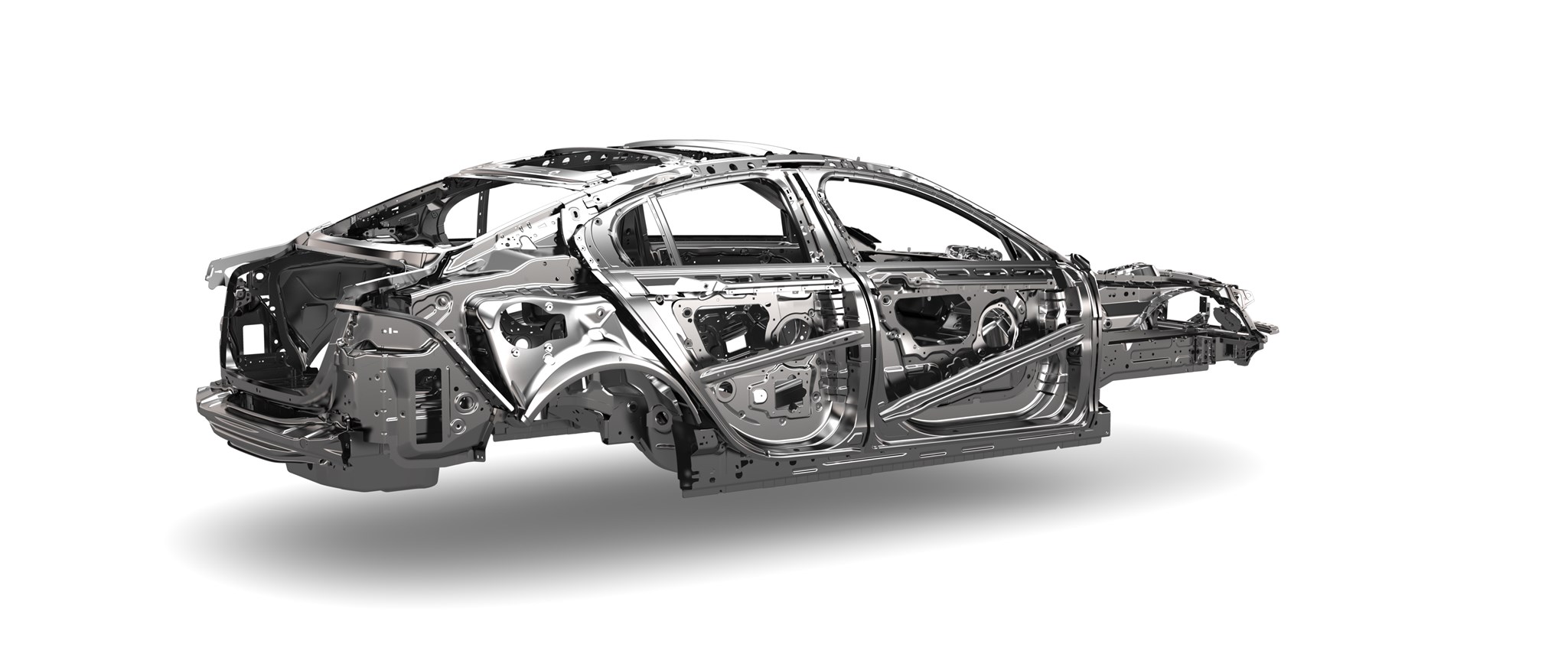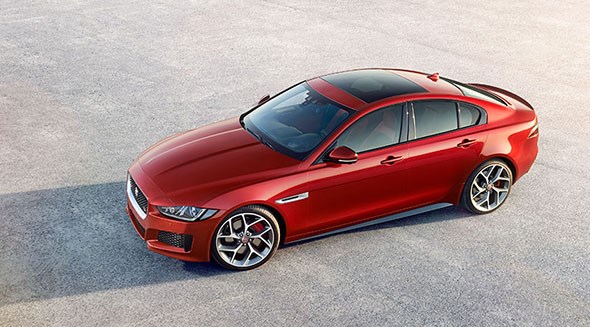This is the new 2015 Jaguar XE – it’s one-part sports saloon, one-part repmobile, and as long as there’s no hint of X-type in it, it’ll be a total nightmare for the BMW 3-series, Audi A4 and Mercedes C-class. Or so Jaguar hopes.
And the XE needs to be that good – it is the most important Jaguar since the E-type. Jaguar and sister company Land Rover have spent a combined $2 billion on a new Wolverhampton facility that’ll produce its engines and the Solihull factory that’ll build the new compact executive alongside aluminium Range Rovers, so the XE has to succeed for Jaguar to survive.
Click here for all of CAR’s Jaguar XE reviews, news, scoops, features and specs.
Jaguar XE: the unique aluminium chassis
The reason the XE is built alongside the aluminium Range Rover and Range Rover Sport is because it too is built from the lightweight metal, on an all-new platform that will also soon spawn Jag’s first-ever SUV and another Range Rover model to slot between the Sport and Evoque. The 3-series et al are all built from steel, so it’s a USP for the XE in its class – and it’s rear-drive too, banishing memories of front-wheel drive X-types.
The weight reduction aluminum offers versus steel benefits both the XE’s fuel economy and dynamic performance (more of both in a minute), but the main reason Jaguar’s been able to start afresh is because it’s had no vehicle in this segment since the Ford-related X-type production was halted in 2009. Every cloud and all that…
The XE isn’t 100% aluminium, though: most of it is, including the doors, bonnet, roof and front and rear wings, but to achieve a 50:50 weight distribution, the rear floor and bootlid are actually made from good old-fashioned steel.
Jaguar XE: the new family of engines
The XE is first to use JLR’s new family of ‘Ingenium’ engines, meaning its aluminium chassis isn’t lumbered with a set of outdated powertrains. All are turbocharged, 2.0-litre, four-cylinder units – with the petrols and twin-turbo diesels to follow later – but at launch the key engine is a 161bhp and 280lb ft 2.0 D. Mix it with a six-speed manual, stop/start, all manner of other eco tricks including active radiator flaps, and the headline figures are 75mpg and 99g/km CO2.
The rivals from BMW and Audi can’t do better than 68.9g/km CO2 or 109g/km, and while the Jag weighs 1474kg, the 320d Efficient Dynamics is 1495kg and the A4 Ultra is 1540kg. That’s not much of a gap to the BMW, but Jag engineers claim the German will gain weight when it becomes EU6 compliant, whereas the XE already meets forthcoming emissions regulations.
This is Jaguar though, and if you’re launching a sports saloon to take on the BMW 3-series, an efficiency race won’t win the hearts of enthusiasts, so the red XE before you is actually the new Jaguar XE S. It uses the 335bhp and 332lb ft supercharged 3.0-litre V6 out of the F-type, and will hit 62mph in 4.9 seconds and reach a 155mph top speed.
An eight-speed ZF auto with paddle shifters, an upgraded differential, an XE S-specific set-up for the adaptive Bilstein dampers, and the more aggressive bodykit are also standard. And if you want more still, an XE R with JLR’s 5.0-litre supercharged V8 and e-diff is coming to take on the BMW M3.
Jaguar XE: can it match the 3-series?
The team behind the XE reckons they’ve got one over the 3-series with its suspension. The BMW uses MacPherson strut front suspension and a multi-link rear, but the XE has double wishbones up front (the reserve of bigger BMWs like the 5-series and 7-series) and XE vehicle programme director Nick Miller told CAR the XE’s ‘Integral Link’ rear is better too.
‘The Integral Link set-up is from the class above and it gives us a big advantage in terms of lateral and longitudinal stiffness, but also in the compliance we can have vertically.’

Miller claims the XE is about 30% more vertically compliant than its rivals with the standard damper set-up, and reckons it’ll have a great ride and sharp handling. We’ll see. Adaptive Bilstein dampers (standard on the XE S) are on option, but air suspension won’t be offered on the XE.
As well as being the lightest Jaguar saloon ever, the XE is also the stiffest. ‘It sits between the F-type Coupe and Convertible in terms of body stiffness,’ says Miller. ‘But as important to us is the attachment-point stiffness, where we’re actually bolting chassis components to. It’s so important for the feel of the steering, the front-end, the tuning you can do of the suspension.’
The XE is also the first Jaguar to use electric power steering (it’s worth a 3% reduction in CO2 emissions) and despite Miller’s assurances it’s up to scratch, we heard the same promises from Porsche about the latest 911…
Jaguar XE: a decent infotainment system (at long last)
After more than a decade with an outdated and achingly slow touchscreen infotainment system, Jaguar now has something modern to offer customers – the new InControl system is shared with the new Land Rover Discovery Sport. ‘In terms of what the customer interfaces with, it’s got an 8in touchscreen with the same technology the iPhone uses,’ says Miller. ‘In terms of responsiveness we’re now delivering a significantly faster system.’

Other tech includes a low-speed cruise control (it works between 2 and 19mph) using know-how from Land Rover’s Terrain Response system, to help out XE customers more used to front-wheel drive on slippery surfaces. Extras include a colour head-up display, an emergency braking function, traffic-sign recognition, lane-departure warning, adaptive cruise control, blind-spot monitoring, automatic parking, and a 10-speaker, 380w Meridian stereo.
Jaguar XE: the design
What do you think then? Jaguar’s released a couple teaser shots of the XE in the past few months (and we’ve been producing scoop images for a number of years) but this is your first chance to finally see the Jaguar XE in the metal, both inside and out. The headlights are slimmer than the XF’s, the side vents are pinched from the F-type (and will feature on other models) and the shape of its taillights are repeated in the daytime-running light element of the rear lamp clusters. The interior attempts to ape the XJ but doesn’t quite seem to pull it off. CAR’s opinion: quite striking at the front, perhaps too much like an Audi at the back, and a little safe overall.
‘The constraint for us is that this car is going into a marketplace which is a hugely pragmatic,’ Jaguar’s direct of design Ian Callum told CAR. ‘You can’t do something overtly exotic like an F-type, so while we had the freedom to do something very exciting, we also had to work with the realism that you can’t be overt to the point of creating a car that doesn’t work for your customers.’
Callum also says the XE had to look like Jaguar’s other saloons, to help strengthen the visual identity of the brand. ‘For me it had to look like a little brother to XF, as part of a family for which we are still building a presence in the world. People need to recognise it as part of this generation of Jaguars, which is not fully known yet, especially outside of the UK.’
Full details of the Jaguar XE range will be announced at the Paris motor show on 2 October 2014, before sales commence in spring 2015, with prices from around £27,000.
